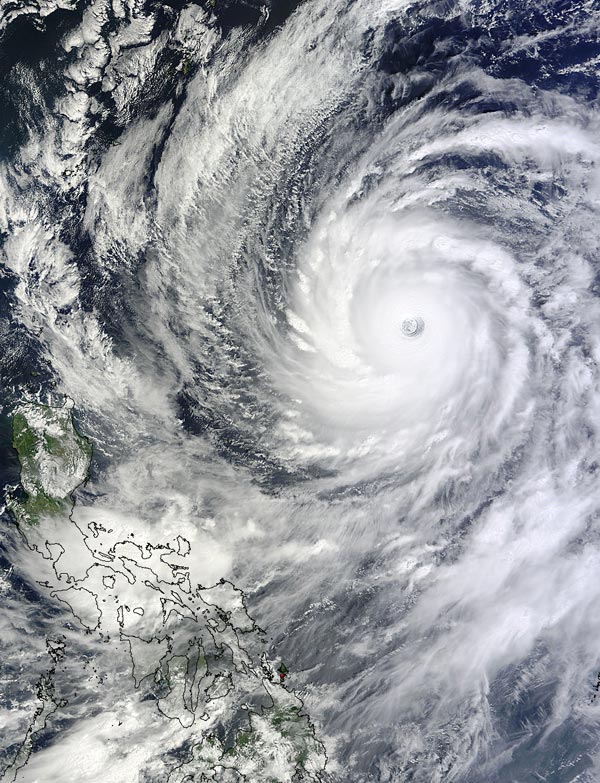Two NASA Satellites Get Data on Category 5 Super Typhoon Vongfong

On Oct. 8 at 02:15 UTC (Oct. 7 at 10:15 p.m. EDT), NASA's Terra satellite captured this view of the wide circular eye in Super Typhoon Vongfong in the Philippine Sea. Image Credit: NASA Goddard MODIS Rapid Response Team
Typhoon Vongfong formed on October 2, 2014 southeast of Guam. Typhoon Phanfone, that recently pummeled Japan, formed near the same area in the western Pacific Ocean.
Vongfong had wind speeds of about 120 knots (138 mph) when the Tropical Rainfall Measuring Mission or TRMM satellite flew above the intensifying typhoon's eye on October 7, 2014 at 0800 UTC (4 a.m. EDT).
TRMM's Precipitation Radar (PR) showed that powerful storms in Vongfong's eye wall were producing very heavy rainfall. TRMM's Microwave Imager (TMI) show that multiple rain bands spiraling into Vongfong were also dropping rain over a large area.
On Oct. 8 at 02:15 UTC (Oct. 7 at 10:15 p.m. EDT), the MODIS instrument aboard NASA's Terra satellite captured a visible image of Super Typhoon Vongfong's wide cloud extend and the storm's wide circular eye.
On Oct. 8 at 1500 UTC (11 a.m. EDT), Vongfong had maximum sustained winds near 145 knots (167 mph/268.5 kph) making it a Category 5 Super Typhoon on the Saffir-Simpson Scale. It was centered near 18.7 north and 130.7 east.
It was centered about 510 nautical miles (586 miles/944.5 kph) south-southeast of Kadena Air Base, Okinawa, Japan. Vongfong was moving to the north at 7 knots (8 mph/13 kph). It was creating extremely rough seas in the Philippine Sea, with wave heights to 50 feet (15.2 meters).
According to the U.S. Kadena Airbase, on Oct. 8, a combined Japanese-U.S. Air Force rescue team recovered the body of the third Airman who had been swept out to sea on Oct. 5 from Typhoon Phanfone.
The Joint Typhoon Warning Center predicts that Vongfong is predicted to weaken slightly while moving toward the islands of southern Japan.
Rob Gutro/Hal Pierce
NASA's Goddard Space Flight Center
Media Contact
All latest news from the category: Earth Sciences
Earth Sciences (also referred to as Geosciences), which deals with basic issues surrounding our planet, plays a vital role in the area of energy and raw materials supply.
Earth Sciences comprises subjects such as geology, geography, geological informatics, paleontology, mineralogy, petrography, crystallography, geophysics, geodesy, glaciology, cartography, photogrammetry, meteorology and seismology, early-warning systems, earthquake research and polar research.
Newest articles

A new look at the consequences of light pollution
GAME 2024 begins its experiments in eight countries. Can artificial light at night harm marine algae and impair their important functions for coastal ecosystems? This year’s project of the training…

Silicon Carbide Innovation Alliance to drive industrial-scale semiconductor work
Known for its ability to withstand extreme environments and high voltages, silicon carbide (SiC) is a semiconducting material made up of silicon and carbon atoms arranged into crystals that is…

New SPECT/CT technique shows impressive biomarker identification
…offers increased access for prostate cancer patients. A novel SPECT/CT acquisition method can accurately detect radiopharmaceutical biodistribution in a convenient manner for prostate cancer patients, opening the door for more…




















